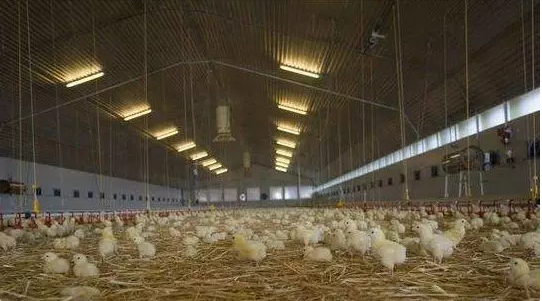直面对工厂化养殖的环境成本
China needs to assess the true costs of factory farming
中国是全球最大的鸡肉和鸡蛋生产国,年肉鸡存栏量90亿只、蛋鸡27亿只,产蛋量近5000亿枚。中国人口数量庞大,个体消费叠加起来给环境带来了巨大的压力。不过由于中国禽类养殖厂多为中、大型的“工厂化养殖场”,公众没有机会看到这些鸡和养殖它们的代价。
China is the world’s top producer of chickens and eggs. Each year, astaggering nine billion chickens are raised for meat and 2.7 billion laying hens produce nearly 500 billion eggs. Given the country’s huge population, individual consumption translates into enormous pressures on the environment. But these costs are mostly hidden as most of China’s chickens are locked inside medium to large scale “factory farms” that are inaccessible to the public.
值此鸡年之际,中国是时候正视工厂化养殖和鸡肉过度消费的真实成本了。
In the Year of the Rooster, China should take the opportunity to assess the true costs of industrial factory farming and the overconsumption of meat.
鸡肉蛋白质吸收率高,被认为是全球广泛食用的主要动物蛋白质来源,但它的水足迹却相当大。世界自然基金会(WWF)在中国开展的一项针对鸡肉生产者的研究显示,每饲养一只肉用仔鸡需耗水19.4升,这就意味着中国90亿只肉鸡每年耗水量高达1750亿升,相当于100万北京居民一年的用水量。
Chicken is considered the most resource-efficient source of widely-eaten animal protein in the world but its water footprint is considerable. A World Wildlife Fund (WWF) survey of chicken producers in China estimated that every“broiler” chicken raised for meat requires 19.4 litres of water. This means that China’s nine billion broilers need an eye-popping 175 billion litres of water annually, enough for one million people living in Beijing.
然而,世界自然基金会的估值还不包括饲料生产用水,这往往是养殖业耗水的大头。中国是全球最大的饲料原料消费国,除了国内生产的之外,还严重依赖拉丁美洲、澳大利亚、东欧和美国的进口。2015年,美国大豆对华出口总额超过100亿美元。
WWF’s estimate excludes water used in feed production, which is usually the biggest consumer of water in animal farming. China is the world’s largest consumer of feed ingredients, and relies heavily on imports from Latin America, Australia, Eastern Europe, and the US, to supplement its domestic production. In 2015, US soybean exports to China were valued at more than US$10 billion.
中国生产的肉鸡每只平均产肉1.4公斤,美国的则是2公斤。为了提高产肉率,并降低资源耗用强度,中国正在加强集约化和工业化生产,这一举动也带来了一系列环境问题,其中最突出的问题就是动物粪便堆积,禽流感(同样也困扰着美国家禽业)等传染病肆虐,在常规养殖周期中过量使用抗生素,遗传多样性降低,以及动物福利恶化等。工业化生产同时降低了小型生态养殖者的竞争力,把他们挤出了市场。
On average, one broiler in China yields 1.4 kilogrammes of meat whereas in the US it’s two kilos. To catch up on the production efficiency and reduceresource intensity, China is intensifying its chicken production but this creates a number of environmental problems; not least the concentration of animal waste; epidemic diseases like avian flu (a problem that bedevils the US poultry sector); overuse of antibiotics in routine production cycles; the loss of genetic diversity; and poor animal welfare. Industrial production also makes it difficult for small and ecologically-oriented producers to compete, crowding them outof the marketplace.

全球禽、蛋产业年温室气体排放量为71亿吨二氧化碳当量,约占畜牧业总排放量的9% 。中国作为全球最大的禽肉和禽蛋生产国,其国内消费对全球排放总量有着重大影响。过度消费动物蛋白可导致肥胖、糖尿病和心脏疾病的发病率增高,尤其在城市地区,这一问题已经愈发成为威胁中国医疗体系以及人民生活质量和寿命的一大挑战。
Greenhouse gas emissions from poultry and egg production worldwide account for 9% of the livestock sector’s overall emissions: 7.1 gigatonnes of carbon dioxide equivalent a year. As the top producer of chickens and eggs, China’s domestic consumption has a significant effect on total emissions. Increasing rates of obesity, diabetes, and heart disease due to overconsumption of animal protein, principally in urban areas, are a growing challenge for China’s health system and individuals’ quality of life and longevity.
养鸡场造成的环境影响也开始引起公众的关注。越来越多的消费者开始购买生态友好的“绿色”食品,认为这种食品更有益健康和环境。这一消费需求也让一些生产者开始采用有机散养法。一些政府机构也意识到了肉类生产造成的各种影响,开始鼓励民众控制肉类消费。
The environmental consequences of chicken farming are also beginning to attract public attention. More consumers are demanding ecologically produced “green” foods that are considered safer for human health and better for the environment. This demand is encouraging some producers to shift to organic and free-range practices. Aware of the various impacts of meat production, some government agencies are also encouraging the public to eat less meat.
商界也行动了起来。商界名人维诺德•科斯拉、比尔•盖茨、李嘉诚以及美国禽类企业泰森已经投资数千万美元,开发以植物蛋白为成分的人造肉类和鸡蛋替代品。
Businesses are also getting involved. Vinod Khosla, Bill Gates, Li Ka-shing, and US poultry business Tyson, have invested tens of millions in plant-based alternatives to meat and eggs.
农业部预测,至少到2024年之前,鸡肉和鸡蛋消费还将进一步增长,同时鸡肉生产也将向规模化转变,且极有可能以工厂化养殖场为主。
The Ministry of Agriculture foresees further growth in the consumption of chicken and eggs at least through 2024, along with a shift to large-scale production of chicken, most likely in factory farms.
通过提高技术和管理技巧能够减少淡水消耗、完善废物处理、减轻水污染、温室气体排放等环境影响,并且改善笼养封闭性和密集度过高的问题,降低流行病爆发的风险,减少不必要的对动物身体的粗暴对待,从而改善动物的生活条件。但产量不断增加也意味着必须扩大饲料生产,这需要扩大大豆等饲料原材料的生产,从而导致森林和草原毁坏、化肥和杀虫剂使用增加、淡水资源遭到污染。
The use of more technology and better management skills may cut down on freshwater usage, improve waste management and lessen environmental impacts such as water pollution and greenhouse gas emissions. It could also improve conditions for chickens by reducing routine mutilations, extreme confinement, and the crowding that increases the risk of epidemic outbreaks. But increasing production also means pressure to expand feed production, which can displace forests and grasslands, increase the use of fertilizers and pesticides, and contaminate freshwater sources.
政府能否认识到大规模工业化鸡肉生产造成的后果,并采取行动确保负责任的生产,目前还有待观察,中国有机会领导其他国家朝着正确的方向前进。
In the Year of the Rooster, it remains to be seen whether the government will acknowledge the consequences of mass industrial chicken production and take action to ensure responsible production. China has an opportunity to lead in a direction that other countries could follow.
政府应削减那些与农户签订限制性合同(农户需在合同期内按企业要求养殖)的大型肉类加工企业的补贴,加大对小规模家庭养鸡场的扶持,帮助他们管理风险、与消费者建立联系,并加强废物处理和水质量相关法律法规的执法工作。此外,政府还应在学校、政府机关和其他大型机构内部推广可持续的食品采购,切实执行减少肉类消费的相关政策。
It should cut subsidies for large meat processing companies that operate through restrictive contracts with farmers, increase support for small scale family farms to help them manage risks and connect to consumers, and enforce laws and regulations on waste treatment and water quality. It should also pursue concrete implementation of the policy on reducing meat consumption by promoting more sustainable food purchasing in schools, government offices, and other large institutions.











